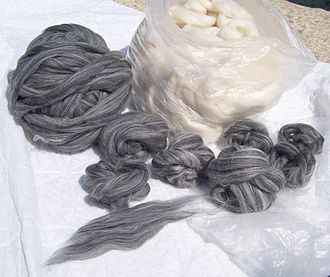Roving
Roving refers to a process or activity involving travel without a fixed destination, often emphasizing the exploration or wandering aspect. In various contexts, it can denote different activities or concepts, ranging from travel and adventure to specific practices in textile manufacturing and archery. This article will explore the multifaceted nature of roving, highlighting its significance in different fields.
Roving in Travel and Adventure
In the context of travel and adventure, roving signifies the act of moving from place to place without a specific destination in mind. This form of travel is often characterized by a desire for exploration, discovery, and the enjoyment of new experiences. Roving adventurers may seek out remote locations, cultural experiences, and natural wonders, embracing the unpredictability and freedom that comes with this travel style.
Roving in Textile Manufacturing
In textile manufacturing, roving has a more technical meaning. It refers to a process in which fibers, such as cotton, wool, or synthetic fibers, are drawn out and slightly twisted to form a loose strand that is intermediate between the initial fiber and the final yarn. This process prepares the fibers for further processing, typically spinning, to create a more cohesive and stronger yarn. Roving in this context is crucial for ensuring the quality and characteristics of the final textile product.
Roving in Archery
In archery, roving refers to a traditional form of practice or competition where archers shoot at random targets set up at varying distances, often in natural terrain. This practice mimics hunting scenarios and was historically used for training. Roving courses are designed to challenge the archer's skill in estimating distance, adjusting for wind, and shooting from different positions, making it a comprehensive test of archery prowess.
Cultural and Historical Significance
Roving, in its various forms, has played a significant role in human history and culture. The nomadic lifestyles of many ancient and indigenous peoples can be seen as a form of roving, where movement was dictated by the seasons, availability of resources, and the pursuit of trade or conquest. In literature and folklore, the figure of the rover or wanderer is often celebrated for their freedom, resilience, and the wisdom gained through diverse experiences.
Conclusion
Roving encompasses a broad spectrum of activities, each with its unique characteristics and significance. Whether through the lens of travel, textile manufacturing, or archery, roving embodies themes of exploration, skill, and adaptability. It highlights a universal human inclination towards movement, discovery, and the pursuit of mastery in various domains.
Transform your life with W8MD's budget GLP-1 injections from $125.
W8MD offers a medical weight loss program to lose weight in Philadelphia. Our physician-supervised medical weight loss provides:
- Most insurances accepted or discounted self-pay rates. We will obtain insurance prior authorizations if needed.
- Generic GLP1 weight loss injections from $125 for the starting dose.
- Also offer prescription weight loss medications including Phentermine, Qsymia, Diethylpropion, Contrave etc.
NYC weight loss doctor appointments
Start your NYC weight loss journey today at our NYC medical weight loss and Philadelphia medical weight loss clinics.
- Call 718-946-5500 to lose weight in NYC or for medical weight loss in Philadelphia 215-676-2334.
- Tags:NYC medical weight loss, Philadelphia lose weight Zepbound NYC, Budget GLP1 weight loss injections, Wegovy Philadelphia, Wegovy NYC, Philadelphia medical weight loss, Brookly weight loss and Wegovy NYC
|
WikiMD's Wellness Encyclopedia |
| Let Food Be Thy Medicine Medicine Thy Food - Hippocrates |
Medical Disclaimer: WikiMD is not a substitute for professional medical advice. The information on WikiMD is provided as an information resource only, may be incorrect, outdated or misleading, and is not to be used or relied on for any diagnostic or treatment purposes. Please consult your health care provider before making any healthcare decisions or for guidance about a specific medical condition. WikiMD expressly disclaims responsibility, and shall have no liability, for any damages, loss, injury, or liability whatsoever suffered as a result of your reliance on the information contained in this site. By visiting this site you agree to the foregoing terms and conditions, which may from time to time be changed or supplemented by WikiMD. If you do not agree to the foregoing terms and conditions, you should not enter or use this site. See full disclaimer.
Credits:Most images are courtesy of Wikimedia commons, and templates, categories Wikipedia, licensed under CC BY SA or similar.
Translate this page: - East Asian
中文,
日本,
한국어,
South Asian
हिन्दी,
தமிழ்,
తెలుగు,
Urdu,
ಕನ್ನಡ,
Southeast Asian
Indonesian,
Vietnamese,
Thai,
မြန်မာဘာသာ,
বাংলা
European
español,
Deutsch,
français,
Greek,
português do Brasil,
polski,
română,
русский,
Nederlands,
norsk,
svenska,
suomi,
Italian
Middle Eastern & African
عربى,
Turkish,
Persian,
Hebrew,
Afrikaans,
isiZulu,
Kiswahili,
Other
Bulgarian,
Hungarian,
Czech,
Swedish,
മലയാളം,
मराठी,
ਪੰਜਾਬੀ,
ગુજરાતી,
Portuguese,
Ukrainian
Contributors: Prab R. Tumpati, MD

